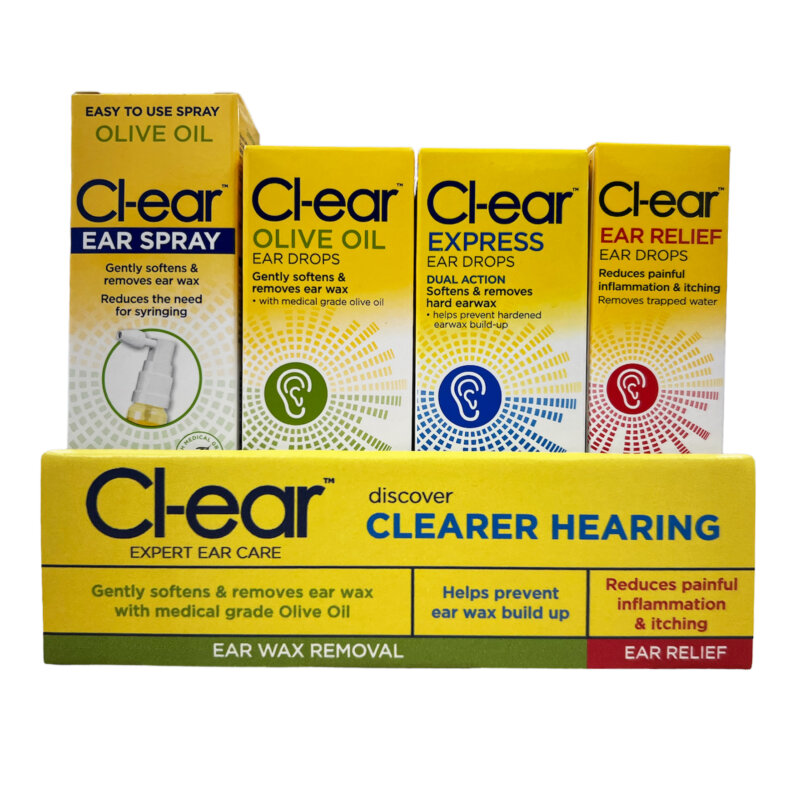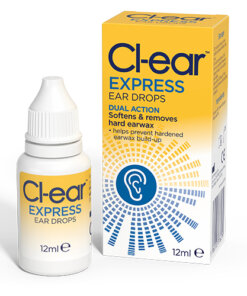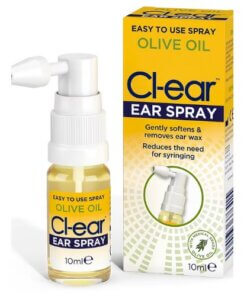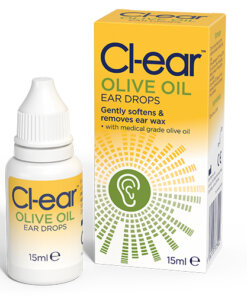
Cl-ear
Ear Wax ? Ear Pain, Itching or Inflammation?
The choice is Cl-ear
Discover the range of Cl-ear specialist ear care products, a range of effective, easy to use treatments to remove ear wax, and a formulation to provide soothing relief for ear pain, itching and inflammation of the outer ear canal¹
If you swim regularly, wear ear pods, use hearing aids, or simply produce excess ear wax naturally, it’s time to give your ears the all Cl-ear treatment.
shop now

More information
The advice on this page is not exhaustive and should not be used to self-diagnose, but it may give you an idea as to what might be causing your ear condition. Always ask your pharmacist or GP for advice.
Source: cl-ear.co.uk
Ear Wax – What is it?
Doctors always say, “Never put anything smaller than your elbow in your ear”. It’s good advice. Ear pods, hearing aids, ear plugs, and even water, in fact anything you put in your ears can be a potential cause of excess ear wax, inflammation and discomfort.
Ear wax is a yellow, orange or brown waxy substance secreted inside the ear canal, and is essential for both ear hygiene and protection. Ear wax assists in cleaning and lubricating the ear canal and provides protection against bacteria, fungi, insects, and water. It usually passes out of the ears harmlessly, but sometimes excess ear wax can build up and block the ears.
A build-up of ear wax is a common problem that can often be treated using eardrops bought from a pharmacy or the healthcare aisle of your supermarket.
Symptoms
A build-up of ear wax in your ear can cause:
- earache
- muffled hearing and hearing loss
- itchiness or discomfort, in or around the ear
- dizziness
These problems will usually improve once the excess earwax has been removed. If symptoms persist or worsen, please seek medical attention.
Causes
Some people regularly get blocked ears because they naturally produce a lot of ear wax.
Other factors that can cause excessive ear wax include:
- Frequent insertion of objects into your ear canal such as cotton buds, ear plugs or hearing aids as they not only stop ear wax escaping naturally but can push the wax further in.
- Narrow or hairy ear canals (the tube between the opening of the ear and the eardrum).
- Age – in older people ear wax becomes drier, harder, and more difficult to remove.
- Bony growths in the outer part of the ear canal.
Treatment
A build-up of ear wax is a common problem that can often be treated using eardrops bought from a pharmacy or local supermarket.
Do not use your fingers or any objects like cotton buds to remove earwax. This will push it in and make it worse.
Cl-ear has a range of products to treat ear wax build up including:
Cl-ear Express Ear Drops – dual action drops to treat ear wax quickly and effectively.
Cl-ear Olive Oil Ear Drops – the natural and gentle way to treat problem ear wax.
Cl-ear Olive Oil Ear Spray – the natural and gentle way to treat problem ear wax in an easy to use spray.
If the product you are using doesn’t work or your symptoms persist or get worse, consult a healthcare professional.
The advice on this page is not exhaustive and should not be used to self-diagnose, but it may give you an idea as to what might be causing your ear condition. Always ask your pharmacist or GP for advice.
Source – cl-ear.co.uk
Ear Pain – What is it?
Ear pain and earache is common, particularly in young children. It can be painful, but is not usually a sign of anything serious.
Symptoms
Earache can be a sharp, dull or burning ear pain that comes and goes or is constant. One or both ears may be affected. How long ear ache lasts depends on what’s causing it.
Spotting earache in babies and young children
A young child might have earache if they:
- rub or pull their ear
- do not react to some sounds
- have a temperature of 38°C or above
- are irritable or restless
- are off their food
- keep losing their balance
Earache and ear pain can affect one or both ears.
Treatment
Your pharmacist may be able to recommend over-the-counter eardrops for your earache, but let them know your symptoms and ask for their advice first.
A pharmacist might be able to tell you:
- what you can do to treat earache yourself
- if you can buy anything to help (for example, eardrops such as Cl-ear Ear Relief Ear Drops
- if you need to see a GP
See a GP if you or your child:
- have earache for more than 3 days
- keep getting earache
- have swelling around the ear
- have fluid coming from the ear
- have hearing loss or a change in hearing
- have something stuck in the ear
- your child is under 2 and has earache in both ears




